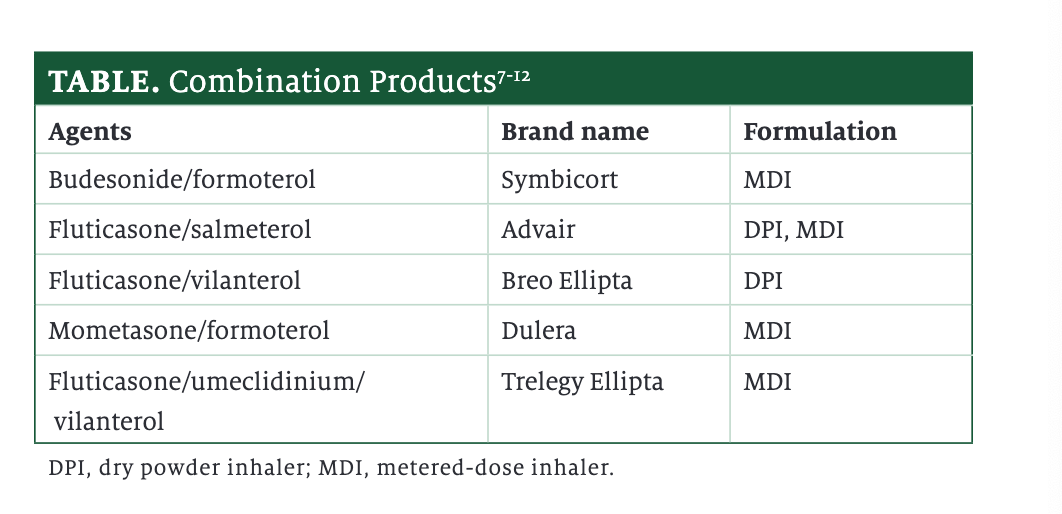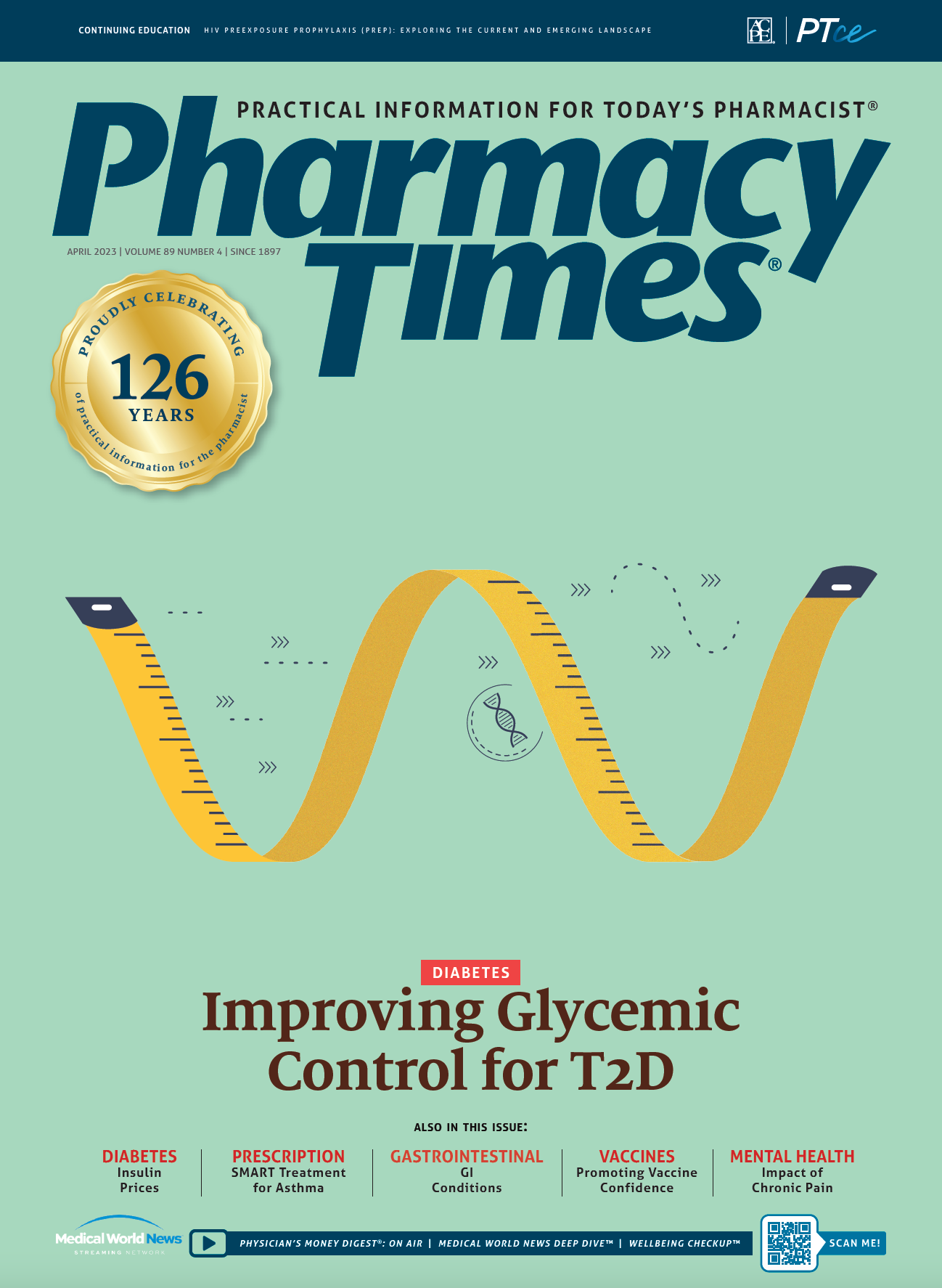Publication
Article
Pharmacy Times
Recent Guidelines Recommend SMART Treatment for Asthma
Author(s):
Teach pharmacy staff members to know and address the roadblocks, keep up with changing guidelines.
Approximately 8% of the US population has asthma.1 Characterized by airway inflammation, bronchospasm, and mucus hypersecretion, asthma causes chest tightness, coughing, difficulty breathing, and wheezing.1 Symptoms tend to fluctuate and can range from mild to severe and include exacerbations (attacks) and flares.2
Typical Treatment
Asthma can be managed with appropriate medications, but many patients have trouble acquiring an inhaler or adhering to their regimen. Inhaled corticosteroids (ICSs), such as beclomethasone dipropionate, budesonide, ciclesonide, flunisolide, fluticasone propionate, and mometasone,3 are the cornerstone of asthma therapy.4 Dosed once or twice daily but more often during exacerbations and flares, all cortico-steroids are equally effective at equipotent doses, but some individuals respond better to specific ICSs.5
Although corticosteroids manage the inflammation, patients need bronchodilators such as short-acting muscarinic antagonists (SAMAs) and short-acting beta-agonists (SABAs) for airway hyperresponsiveness and exacerbation and during exposure to triggers.3 Usually, all patients with asthma are prescribed SABAs as a relief inhaler, with albuterol metered-dose inhalers being the most common.3 The number of relief inhalers a patient uses is something clinicians should monitor, given that asthma outcomes worsen as the use of relievers increases.
Patients who purchase 3 or more albuterol inhalers annually, which translates to 1.6 puffs per day, are at risk of severe exacerbations and death.6
Changing Guidelines for Relievers
The Global Initiative for Asthma recently changed its recommendations on SABA use. Research results indicate that SABAs are more effective when followed by an ICS.6 Even in patients with infrequent symptoms, a prescription for a daily low-dose ICS reduces the risk for asthma and its symptoms. Although less effective, SAMAs such as ipratropium can be used if patients cannot tolerate SABAs.
Long-acting beta-agonists (LABAs) such as formoterol and salmeterol and long-acting muscarinic antagonists (LAMAs) are maintenance drugs for daily use. LABAs are never used alone but instead to augment ICS.3 All LABA inhalers have a boxed warning concerning potentially severe asthma exacerbations, some of which have resulted in death. Using LABAs in combination with an ICS reduces these risks. Patients 6 years or older can use tiotropium as an add-on LAMA in maintenance therapy.
When patients require multiple inhalers, which is often, combination inhalers increase ease of use, efficacy, and adherence by reducing confusion as to how and when they should be used. Clinicians can assess adherence and correct medication use when patients are on combination products. With this information, they can determine whether patients need education or a higher dose. The TABLE7-12 lists the combination products available.

According to the Asthma Management Guidelines updated in 2020 by the National Heart, Lung, and Blood Institute, if symptoms are well controlled with 2 inhalers, it is appropriate to maintain that regimen, but Single Maintenance and Reliever Therapy (SMART) is recommended for patients with moderate to severe persistent asthma aged 4 years and older. SMART employs a single ICS/formoterol combination inhaler dosed daily and as needed for asthma exacerbations. This is a significant change, and all pharmacy staff should take note. SMART medications are FDA approved in patients 12 years or older. The guidelines also recommend off-label use of SMART in children aged 4 to 11 years.1
SMART Reduces Stress
To understand how this update helps patients, pharmacy teams should review recent history. Before 2020, patients with moderate persistent asthma were prescribed 2 inhalers: a daily ICS for maintenance and a SABA for relief. If symptoms persisted, prescribers added a LABA to the regimen. SMART reduces the number of inhalers required from 3 to just 1. In the past, the only reliever option was SABA. Now, ICS/LABA combination is an option, which is a significant change.1
One stressful situation occurs when patients present with an ICS/LABA prescription labeled with SMART directions. Sometimes pharmacists who are unaware of the recommendations tell patients that the directions are wrong. Although the guidelines are 3 years old now, it has taken time for change to filter down to the front line.
At other times, difficulties with insurance arise. Many pharmacy benefits managers impose strict quantity limits, and at least 1 insurer uses a limit that is below the maximum daily adult dose.
When an adult’s prescription is rejected because of quantity limits or a child’s prescription is rejected because it is off label, the prescriber must file a prior authorization request to override the quantity limit, citing the guidelines. If the insurer still rejects the claim, the prescriber can ask for a peer-to-peer review.
Patients and prescribers can also take up the case with the employer’s benefits manager, insurer, and state health advo-cacy office, but this takes time and effort.
Conclusion
Keeping up with numerous guideline updates is difficult but critical. Unfortunately, pharmacy staff are sometimes caught in the middle between patients who need medication and insurers that have not adjusted their formularies to reflect new evidence. Advocating for change and explaining that prior authorization is needed can resolve the problem and prompt insurers to make note of new guidelines.
References
1. What is asthma? National Heart, Lung, and Blood Institute. Updated March 23, 2022. Accessed March 31, 2023. https://www.nhlbi.nih.gov/health-top-ics/asthma
2. Centers for Disease Control and Prevention. Vital signs: asthma prevalence, disease characteristics, and self-management education: United States, 2001-2009. MMWR Morb Mortal Wkly Rep. 2011;60(17):547-552.
3. Sharma S, Hashmi MF, Chakraborty RK. Asthma Medications. StatPearls. 2023. Accessed March 30, 2023. https://www.ncbi.nlm.nih.gov/books/NBK531455/
4. Williams DM. Clinical pharmacology of corticosteroids. Respir Care. 2018;63(6):655-670. doi:10.4187/respcare.06314
5. Phillips K, Oborne J, Lewis S, Harrison TW, Tattersfield AE. Time course of action of two inhaled corticosteroids, fluticasone propionate and budesonide. Thorax. 2004; 59(1):26-30. doi:10.1136/thx.2003.015297
6. Reddel HK, Bacharier LB, Bateman ED, et al. Global initiative for asthma strategy 2021: executive summary and rationale for key changes. Am J Respir Crit Care Med. 2022;205(1):17-35. doi:10.1164/rccm.202109-2205PP
7. Symbicort. Prescribing information. AstraZeneca; 2017. Accessed March 30, 2023. https://www.accessdata.fda.gov/drugsatfda_docs/la-bel/2017/021929s013lbl.pdf
8. Advair Diskus. Prescribing information. GSK; 2008. Accessed March 30, 2023. https://www.accessdata.fda.gov/drugsatfda_docs/la-bel/2008/021077s029lbl.pdf
9. Advair HFA. Prescribing information. GSK; 2017. Accessed March 30, 2023. https://www.accessdata.fda.gov/drugsatfda_docs/label/2017/021254s026lbl.pdf
10. Breo Ellipta. Prescribing information. GSK; 2017. Accessed March 30, 2023. https://www.accessdata.fda.gov/drugsatfda_docs/label/2017/204275s012lbl.pdf
11. Dulera. Prescribing information. Merck & Co., Inc; 2015. Accessed March 30, 2023. https://www.accessdata.fda.gov/drugsatfda_docs/la-bel/2017/022518s021lbl.pdf
12. Trelegy Ellipta. Prescribing information. GSK; 2017. Accessed March 30, 2023. https://www.accessdata.fda.gov/drugsatfda_docs/la-bel/2017/209482s000lbl.pdf
About the Author
Jeannette Y. Wick, MBA, RPh, FASCP, is the director of pharmacy professional development in the Department of Pharmacy Practice at the University of Connecticut School of Pharmacy in Storrs.

Newsletter
Stay informed on drug updates, treatment guidelines, and pharmacy practice trends—subscribe to Pharmacy Times for weekly clinical insights.






